The whole idea of a survival garden is that it contains plants to enable you and your family to eat well when there may be no access to shops, that it is hidden from sight to discourage theft of food, and for food security it should include some plants that the average person would not easily be able to identify and, perhaps, steal.
What may look like an ornamental shrub, vine or tree could actually be a worthwhile source of food for your family. If the fruit is sufficiently exotic, people who haven’t encountered it before won’t touch, as they may assume it’s poisonous.
Some of the plants provide both fruit and very thorny protection for the perimeter of your property, while others will climb in amongst your trees. Some even hide their bounty underground.
1. Egyptian Spinach
Corchorus Olitorius, also known as Molokhia will thrive in a warm climate. The older leaves should be cooked, but as with ordinary spinach, the younger leaves can be eaten raw in salads or placed into wraps with other vegetables and shredded meat.
This is an annual plant, but self-seeds readily and grows to a height of 3 to 5 feet. It is eaten across the Middle East, East Africa and North Africa as an alternative to common spinach.
Start the seeds around 6 weeks before the last frost of the season so you can plant out and take advantage of the spring weather. The plants take 70 days to maturity and it is best grown as an annual.
With care, they can be grown from Zones 4 through 7 and in warmer climates from Zone 8 through 12. Learn how to pickle the seed pods here:
2. Cucumelons
Although relatively well known among permaculture practitioners, the tiny watermelon lookalike fruit, also known as mouse melons, are not yet on everyone’s radar. They provide loads of tiny little fruit that can be eaten fresh, chopped into salsa and salads, or even pickled.
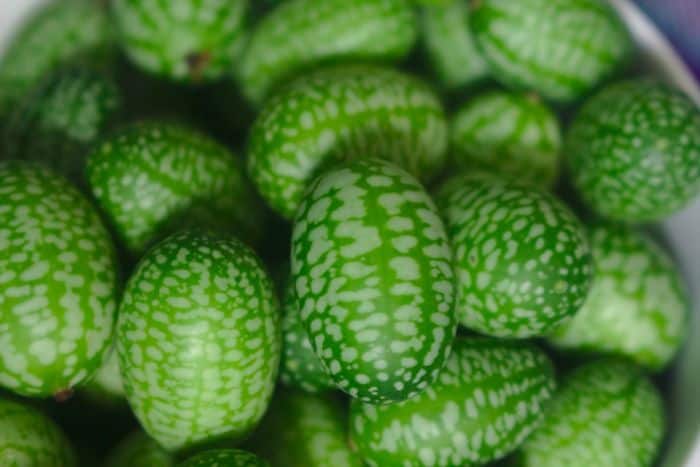
They are juicy, a little sour, and can be described as refreshing when eaten raw. They are also known as the Mexican gherkin.
They grow into sprawling vines that will climb into trees, or you can provide a trellis for them. Buy them online or try your local seed store.
Learn more about growing cucumelons here:
3. Tigernuts / Chufa
Introduced by the Arabs, these are grown in Spain, and have spread to many parts of the world. Chufa produces sweet tubers that look something like chickpeas ,but they taste a bit like coconut. They are high in fiber, and are a good alternative for people with nut allergies as they are not a real nut, but a tuber.
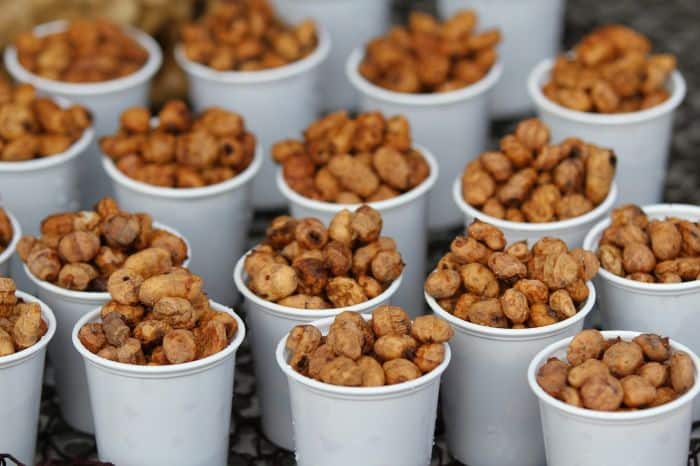
The ancient Egyptians, Persians and Chinese knew all about tiger nuts and their nutritional properties as they are rich in potassium, magnesium, zinc, and Vitamin E. These grow well in very loose sandy soils.
Soak the small edible tubers for 24 hours before planting around 4 inches apart and 1 ½ inches under the soil. Keep soil moist until the grass-like shoots appear, and keep watering until the shoots shrivel up which is a signal that the tubers are ready to harvest.
Plant in April in the US in zones 8 to 10, and harvest after the summer. If you don’t plant in very loose soil you will have trouble digging up the tiger nuts. The uninitiated would never know your straggly ‘grass’ was actually very edible because the good part is hidden underground.
The tiger nuts can be eaten raw, but are easier to chew once they have been boiled and can be added to various dishes or eaten as a snack. If you want to know more about growing tiger nuts watch here:
4. Malabar Spinach
Also known as Guyana thick leaf callaloo, Ceylon, Chinese, Surinam or Vietnamese spinach among a host of other names, this climbing vine is ideal for a survival farm as it can grow either on a trellis or arbor, or can be allowed to climb up existing trees in your food forest.
Quick disclosure: If you visit a link in this article and then you buy something, I may earn a commission. As an Amazon Associate I earn from qualifying purchases. You can read my full disclosure here.
Malabar spinach is from India, so appreciates a warm climate. It will grow in USDA zones 10 to 13 but will survive as a summer crop in zones 7 to 9. Get your seeds here, and learn all about growing it here:
5. Tomatillos
Producing tomato-like fruit which is a little less sweet and slightly more acidic than conventional tomatoes, tomatillos are used to give Mexican salsa verde its unique taste. Tomatillos also taste good roasted.

They come in a little cape, like a gooseberry, so are somewhat undercover. They take around 70 days to maturity and are not meant to over winter, so will grow in USDA zones 3 to 12, if you grow them with care in the cooler zones.
6. Sweet Prickly Pear
Originally from Central America these plum shaped fruit from the Opuntia ficus-indica plant are a delicacy. These cactus plants can be used to form a hedge that keeps unwanted visitors out as the spines are wicked.
If you brave them, you can harvest the fruit (you’ll need gloves), which can range from green to orange or red. The riper it is, the sweeter the taste.
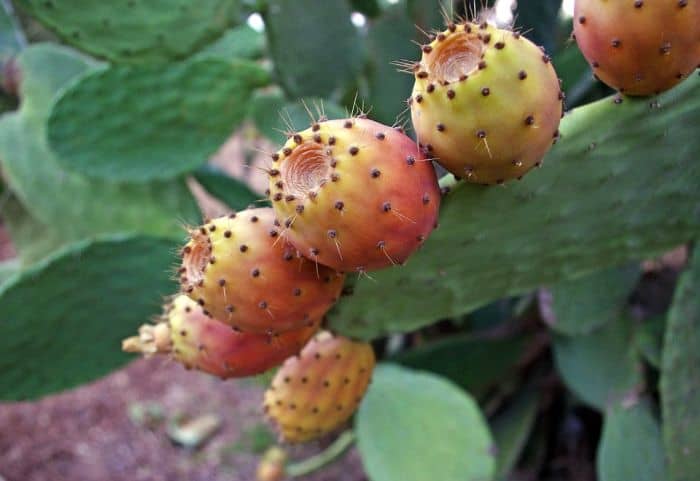
You’ll also need thick leather gloves to work off the small hairlike spines, called glochids, on the fruit itself which can stick in your skin and be hard to remove. Peel the fruit carefully and place in the refrigerator.
They are delicious sliced and eaten cold. If you don’t know someone who can give you a piece of this cactus, or can’t find at your local nursery then you can order frozen seed capsules here
Sweet Prickly pears grow in zones 8 to 12 in a well-drained soil.
7. Daikon Radish
These radishes are nothing like the little pink and white ones we are more used to. They look like an enormous carrot was crossed with a white turnip. Daikon radishes are used in Asian cooking and are tasty without the bitterness of a turnip.
Add them to stews and soups as well as stir fries. They can be steamed and served with butter.
They are great to interplant among other ornamentals o herbs in your survival garden to make their presence less obvious. Get your daikon radish seeds here.
8. Pineberries
The flavor of this Chilean native is something between a pineapple and a strawberry, with the fruit looking like a white strawberry with little red seeds on it.
Pineberries go equally well with sweet and savory dishes, so feel free to use them in salads, serve with ice cream or supply some halved ones with a rich venison stew for a fresh contrast. You can get plants here.
9. Velvet Apple
Grown in the Philippines Diospyros blancoi also known as the velvet apple is a relative of the persimmon, of which, Diospyrus fuyu has become very popular.
Velvet apples can range from yellow gold to orange and a deep red. They look very attractive but the taste is a bit like a mango strawberry yoghurt. The darker the fruit, the sweeter it is.
Velvet apples are rich in potassium and calcium. Although it is a relative of the popular persimmon, they are quite hard to find in the US and need a tropical climate in which to thrive. Watch here to see what they look like:
10. Amartungulu, Num num fruit (Carissa macrocarpa)
These viciously thorny plants can be trained as hedges for protection as the forked thorns are efficient at repelling unwanted visitors. They produce flat white star shaped flowers with five petals.
The fruit of the Carissa macrocarpa is red and sweet tasting and looks like a jam tomato – having an oval shape and about two inches long. They are often used in jams and for tarts. The fruit is rich in pectin that helps set the jam, and contains significant amounts of calcium, magnesium, and Vitamin C.
It can be added to pear or quince jam for added flavor and to encourage setting, and is also useful in adding to chutneys, relishes and onion marmalade.
When you cut an amartungulu fruit, it exudes a white liquid. It is native to the coastal regions of South Africa where it can endure quite harsh growing conditions, and is often called the Natal plum or big Num Num.
The plant was introduced to the US as far back as the 1880’s. It is useful as an ornamental plant as it can be pruned into neat Japanese looking mini-trees, plus it produces fruit which most people won’t be familiar with – being bright red they may leave it alone, fearing it is poisonous.
The plants grows in zone 9 to 11 but in zone 9 may die right back if it gets very cold. You could try getting seeds here, or your nurseryman may be able to help locate these plants.
11. Rambutan
Also known as hairy lychees, the Rambutan grows prolifically in South East Asia. In the US it will grow in Zone 12 and 13, needs plenty of water, and enjoys full sun (but will tolerate partial shade).
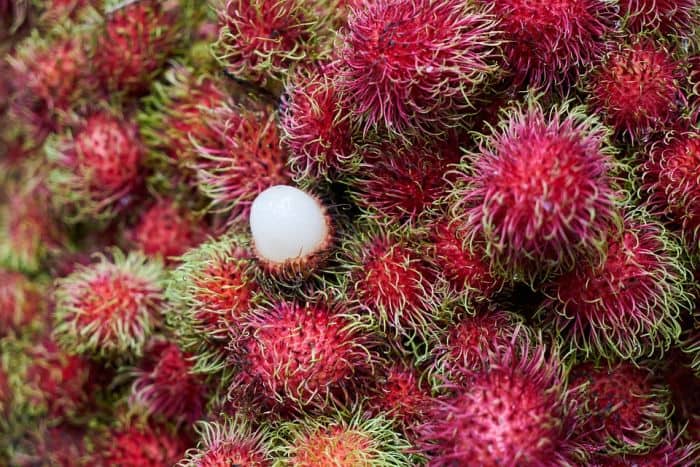
The trees grow to between 15 to 30 foot and the fruit will appear from between 2 to 3 years on budded trees, and maybe 5 to 6 years on trees grown from seed. The bunches of hairy red fruit have a white interior and taste similar to a lychee.
You can try a nursery specializing in tropical fruit trees if you want to add one of these to your survival garden. Rambutans are sold at roadside stalls in Asia and are a popular fruit.
Watch this to see how to grow your rambutans:
12. Mangosteen
The first time I was presented with a platter of mangosteen fruit at a hotel breakfast in Bali I was fascinated, “What is this?” I asked. “Very nice,” was the reply, “you try.” I did and was hooked.
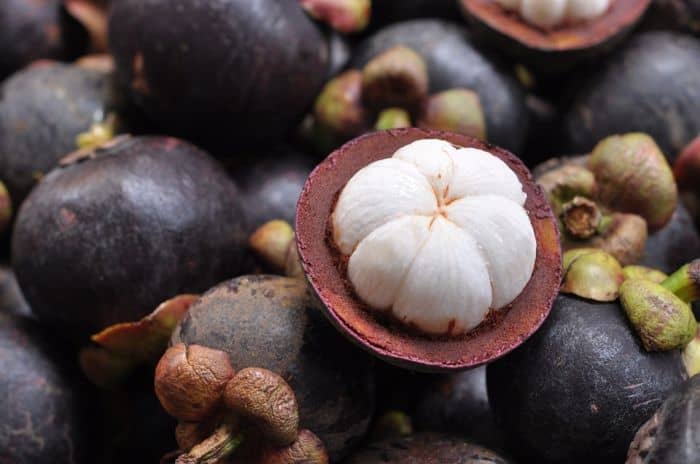
The white fruit is delicious, sweet, juicy and a little fibrous. There is a thick purplish leathery exterior to get through before you can appreciate the white flesh. It’s hard to say what the soft fruit, arranged in circular segments like the petals of a flower, tastes similar to, it’s kind of a mix of lychee, banana, and peach.
Mangosteens are, however, one of the hardest trees to grow, which is why the fruit is so expensive. They are tropical trees and temperatures must be high and even, with high humidity – typical of an equatorial zone.
If the temperature drops below 40 degrees F they will die. Seedlings are even more temperamental, and will die if the temp dips to 45 F. They are also slow growing and take 15 to 20 years to bear fruit.
This tree grows to 85 foot high. It is not easy to find seedlings, but you can try Pepesplants.com, and if you want to germinate them successfully then watch this video
13. Star Fruit / Carambola
I love this ridged banana shape fruit as an addition to salads because of its pretty shape when cut – it forms natural stars. It tastes like apple and is crisp. I find it great for floating in drinks, adding to fruit salads or on the side with hearty stews to contrast with the fat content of the meat.
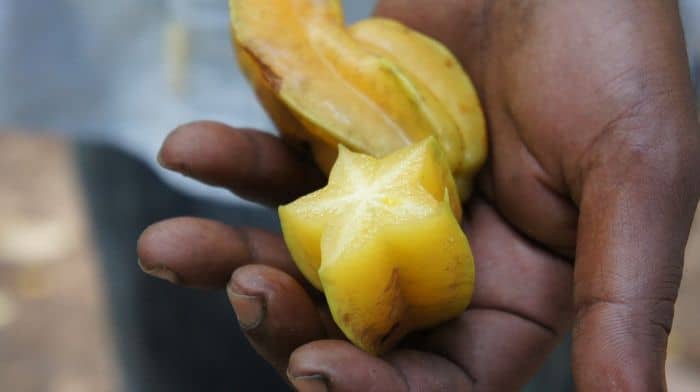
They are suited to growing in Zones 10 to 13, and the trees bear prolifically, so they’re definitely worthwhile adding to your garden.
If you’re prepared to wait you can buy seeds here. See all about growing them here:
14. Sapodilla Nispera
The fruit is oval, light brown and has a soft fuzz on it, something like a kiwi fruit, but the sapodilla is a tree, not a vine like the kiwi. They need full sun and will grow in USDA Zone 10b: to 1.7 °C (35 °F) and USDA Zones 11 to 13, above 4.5 °C (40 °F).

Also known as Chikoo the sweet fruit has a bit of a malty flavour with the sweetness of pear. The yellow brown flesh can be scooped out and eaten plain, added to smoothies, pancake and muffin batters, used in fruit salads, or as a refreshing touch to other salads.
If you have the patience you can start your plants from seed , or try a nursery specializing in tropical/sub-tropical plants.
15. Surinam Cherry, a.k.a. Brazilian Cherry
Looking like mini red pumpkins, the taste of this fruit is one you either love or hate. As a child, there were many growing on a second property owned by my parents, and whenever we visited we kids would climb into this feast.
The scent of them is quite strong – you certainly know when a tree is in the area. Called cherries, they don’t taste like a cherry at all, and have to be picked super ripe – like bluish-red ripe otherwise the taste is astringent.
Don’t try the orange red ones. It makes a good hedging plant. You can learn more about them here:
…and if you would like a plant try contacting Eldon Tropicals, Ocala, Florida.
16. Dragonfruit
This climbing cactus, Selenicereus undatus, produces a gently flavoured pinkish red fruit that is white inside with tiny black seeds. You will find it at fruit stalls all over South East Asia, and its popularity is growing. They are great juiced or sliced and served cold.
You need to support the cactus as the bracts become heavy and break easily. They are hardy in Zones 10a to 11. If it’s too hot they tend to take strain and if it’s too cold they will not bear. Learn how to look after them here.
They will start to produce fruit within 6 to 8 months if planted in the ground but in a container can take up to two years to produce fruit. They grow fairly easily from seed which you can obtain here.
17. King Coconut
If you are only used to the brown fibrous coconut then you are missing out. The King coconut doesn’t have that hard husk and is much easier to prepare. Cocos nucifera var. aurantiaca has an orange color exterior and is football shaped, and produced in clusters of around 20 coconuts.
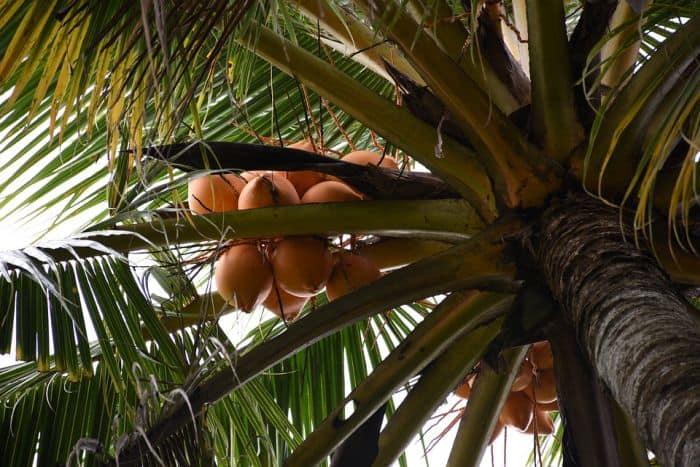
King coconuts will grow in USDA zones 10b to 12. This native of Sri Lanka is sweeter than the ordinary coconut. Try your local nursery if you live in a zone suited to these coconuts or perhaps try growing one bought from a market.
See how to propagate them here:
18. Yacon
This South American plant has taken off in popularity recently. It’s a hardy perennial that produces tubers that are crunchy with a taste that can be described as sweet like sugar cane with apple and watermelon flavors.
The foliage is attractive, and will blend into a survival garden without a hint of the deliciousness under the soil – the perfect undercover plant.
19. Choko / Chayote
Personally, I find these very mild tasting but they do look very attractive on a plate when steamed and sliced as they retain their bright translucent green color, and can be spiced up with some paprika or chili.
They are quite expensive if you can find them at a greengrocer. They tend to go whitish green if roasted. They have only 1% of the RDA of carbohydrates, 6% dietary fiber, and no fat. Only 19 calories per 100g serving makes them a good choice for those counting their calories.
The vines will grow in your food forest. They are sub-tropical so will flourish where it is warmer, but you can grow them from Zones 5a upward. Learn about growing chokos here:
20. Black Sapote
Yes, the photo of the fruit does not look amazing – but then does a photo of chocolate pudding close up look good? A native of Mexico this pant has become popular with survival gardeners as the fruit is known as chocolate pudding fruit because it tastes delicious!

The tree grows massive – up to 80 foot high. Grow it in zones 11 to 13. Try growing it at home:
21. Salsify
This plant looks something like a brown stick – rather unappetizing but the taste can be compared to oyster.
It was first grown in the Mediterranean area and is not grown in the UK and the US as well as other countries. The oyster plant should be tried out – you can see how to grow it here https://www.youtube.com/watch?v=5D0gJMcq8I0&ab_channel=suburbanhomestead
22. Finger Limes
When you see this fruit on the tree in the rainforest, you would never associate it with a lime.
It’s brown, the size of a finger, and hangs from the tree looking pretty dry and unattractive, but open one up. and the citrusy flesh is arranged in little beads like caviar that can be squeezed out with gentle pressure, and makes a very attractive addition to a drink.
The tree has tiny thorns that aren’t immediately visible– I ran my hands over the pretty little leaves and received a nasty surprise! They make good container plants too.
Learn more about finger limes here:
23. Quince

These have been around a long time but don’t seem to be a modern favorite, although years ago people had quince hedges. They grow well in California. See all about caring for them here:
24. Oregon Grape
There are various varieties, and they have something of a sour patch taste. Don’t bite into the seeds – they are super sour. Oregon grape can be used in jams and jellies, and make a very good dye.

Best in zones 5 to 9, this shrubs enjoys partial shade although it will tolerate full shade.
25. Panama Berry
Muntingia calabura is also known as capolin in Mexico. When ripe, the fruit is a deep red and is shaped like a tiny pomegranate. The taste is kind of like strawberries and toffee. It can be used in jams and tarts, also as a sauce, like cranberry with meat.
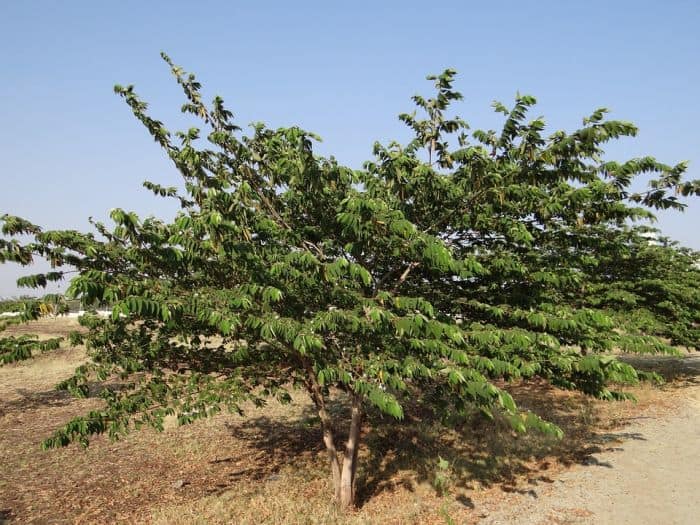
Hardy in zones 10 to 11, otherwise it must be grown in a greenhouse. It is tolerant of different types of soils as long as they are well drained. The medium size tree is fast growing.
26. Pacific Crabapple
Commonly known as deer candy the fruit is soft and tastes a little like apple cider. The plant can be found between southern Alaska and down to northern California on the coastal side of the Cascade Mountains.
It likes to be near water so is found near estuaries and around wetlands. This medium size deciduous tree will be a welcome addition to a survival garden – the only native apple tree in the west. This video gives some details on Pacific crabapples (that are hardy to zone 6):
27. Borojo Fruit
Native to the Colombian rain forest this tree produces fruit that is ripe only when it falls to the ground. If picked before this stage it will have a strong and bitter taste.
The fruit pulp is added to ice cream and beverages. It has high levels of phosphorus and contain three times more amino acids than meat! Be aware that it is a rain forest tree and will only grow well in zones 10 to 13.
You need a male and a female tree to have successful fruiting. Learn a little more about borojo fruit here:
28. Quandong
Found in the semi-arid regions mainly in South-Eastern Australia, the red fruit of the desert quandong (Santulum acuminatum) tastes a bit like a mix of peach and apricot. Its benefit is that it scavenges free radicals from the body.

It is drought tolerant, and can take saline soils. It’s the same size as a Brazilian or Surinam cherry, only the fruit is smooth without the pumpkin like ridges of the Brazilian cherry.
People with food forests may be successful with this plant as it takes nourishment from the root systems of other trees in close proximity – trying to grow it alone or in a container would be impossible – it may last for a while, but won’t thrive.
The fruit can be dried and lasts for years. The fruit is used in jams, chutneys and as a pie filling. If you are buying seed only the desert quandong is edible – the blue quandong is not.
You can learn more about quandongs here:
They may be difficult to find outside of Australia, but try here for information on obtaining seeds.
29. Snakefruit – Rattan
The exterior of this fruit reminds a person of the scales on a snake – the skin is textured. Inside the fruit has a lemony taste.
It will grow in zones 10b to 12 and the palm has various uses – the Calamus palm has fronds that can be used for furniture and woven into panels for housing, and basketmaking.
Learn more about the rattan palm family here:
30. Red Bananas
Another South East Asian plant, these have a red skin but on the inside they look like the usual banana, but taste a little sweeter, with a hint of raspberry. Try here for seeds.
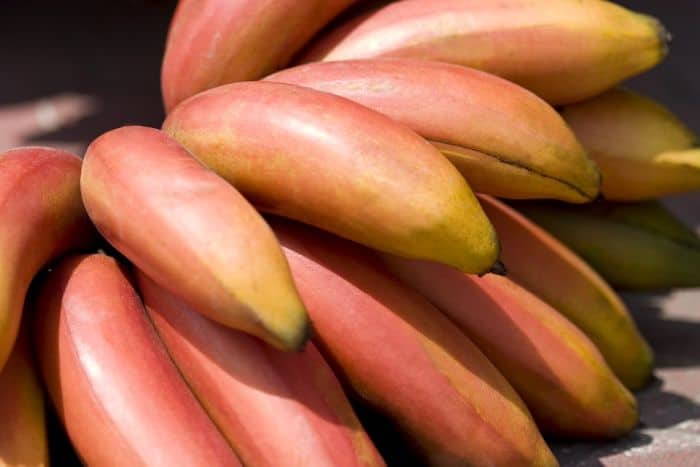
Like most bananas, they require a warm climate, and will thrive in zones 10 to 13. Some tips on growing them can be obtained here:
31. Fiddleheads
These are curled fronds from young ferns of the ostrich fern (Matteuccus struthiopteris). They get their name because of their coiled heads, which resemble the neck and head of a fiddle.
It can be hard to identify the correct type of fern, so watch here for tips on identifying them:
Fiddleheads are reported to have a nutty asparagus taste when fried lightly, and can be served raw or cooked.
Final Words
So, have you tried growing any of these plants? Let us know in the comments section below.

Jeanie is an avid camper and a cook. She likes to do pioneer recipe sin particular, and any other type of survival food that our great-grandfathers loved.


very neat, some I’ve heard other I have not most of these would not do good in my area we are to cold. I’ve used a few of the fruits, and we are starting to see them in the supermarket, thanks for sharing your knowledge ?